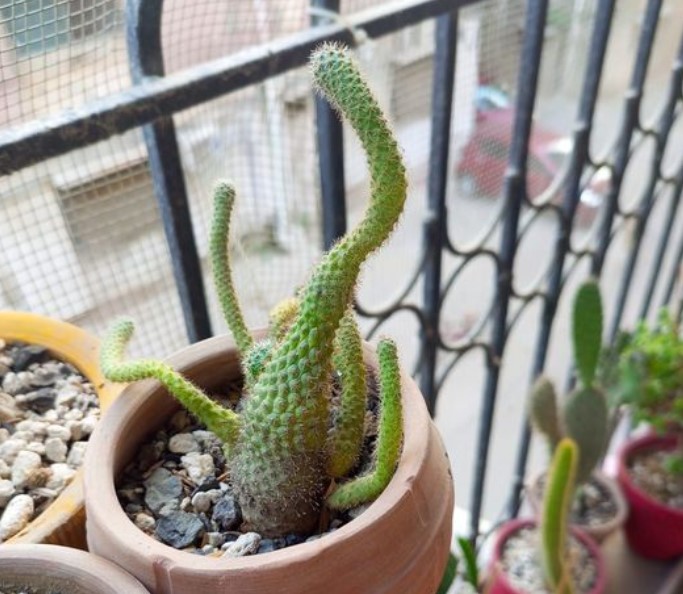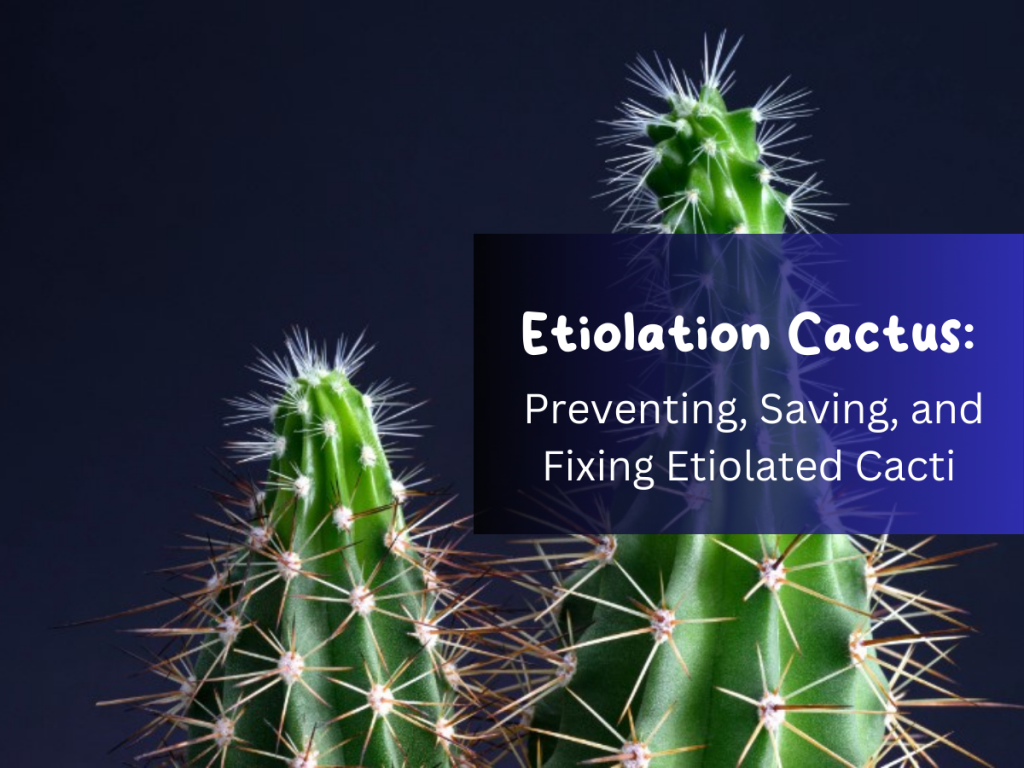Cacti are renowned for their ability to thrive in arid environments thanks to their unique adaptations. However, even these resilient plants can experience a growth issue known as etiolation. In this comprehensive guide, we will explore the causes of etiolation in cactus and provide practical tips to prevent and treat this condition, ensuring your cacti remain healthy and vibrant.
Etiolation in cacti refers to the abnormal elongation and weakening of the stem or branches caused by a lack of sufficient light. When a cactus does not receive enough light, it stretches and elongates in search of more light, resulting in weak, pale stems and an overall distorted appearance.

Causes of Etiolation in Cacti:
- Insufficient Sunlight: Cacti require ample sunlight to thrive. When placed in areas with limited light exposure, they may stretch and elongate in search of more light, leading to etiolation.
- Inadequate Light Spectrum: Cacti need a balanced spectrum of light that includes both blue and red wavelengths. Insufficient blue light, often found indoors, can contribute to etiolation.
- Lack of Proper Air Circulation: Poor air circulation around cacti can limit their ability to transpire and exchange gases effectively. Stagnant air can impede their growth and lead to etiolation.
- Improper Watering and Soil Conditions: Overwatering or using heavy, moisture-retaining soils can cause root rot and hinder nutrient absorption. This can weaken the cactus and make it more susceptible to etiolation.
- Nutrient Deficiencies: Insufficient levels of essential nutrients, such as nitrogen, phosphorus, and potassium, can affect a cactus’s overall health and growth, potentially leading to etiolation.
Recognizing Etiolation in Cacti:
To identify etiolation in cacti, look for the following signs:
- Elongated and weak stems or branches.
- Pale or yellowish coloration.
- Sparse or reduced spines.
- Abnormal leaning or bending towards the light source.
- Stunted or slowed growth compared to healthy cacti.

Preventing Etiolation in Cacti:
- Providing Adequate Sunlight: Place your cacti in a location that receives at least six hours of direct sunlight daily. Consider placing them near a south-facing window or using artificial grow lights that provide a balanced light spectrum if growing indoors.
- Ensuring Proper Light Spectrum: Supplement natural light with grow lights that emit blue and red wavelengths, or use full-spectrum fluorescent bulbs to ensure your cacti receive the proper light spectrum for healthy growth.
- Enhancing Air Circulation: Place fans or ensure gentle airflow around your cacti to promote transpiration and gas exchange. Avoid exposing them to drafts or extreme temperature fluctuations.
- Watering and Soil Requirements: Water your cacti sparingly, allowing the soil to dry out between waterings. Use a well-draining cactus potting mix that provides good aeration and prevents waterlogged conditions.
- Providing Optimal Nutrients: Feed your cacti with a balanced cactus fertilizer during the growing season to ensure they receive essential nutrients. Follow the recommended dosage instructions and avoid over-fertilizing, which can harm their health.
Treating Etiolation in Cactus:
- Pruning and Propagation: If etiolation has occurred, consider pruning the elongated stems or branches. You can propagate these cuttings to grow new, healthier cacti. Be sure to allow the cuttings to callus for a few days before planting them in well-draining soil.
- Adjusting Light Exposure: Gradually acclimate etiolated cacti to brighter light conditions to prevent shock. Start by increasing their exposure to direct sunlight or changing the position of grow lights gradually over a few weeks.
- Correcting Watering and Soil Issues: If overwatering or poor soil drainage contributes to etiolation, adjust your watering routine and repot your cacti using a well-draining cactus mix.
- Nutrient Supplementation: Address nutrient deficiencies by applying a balanced cactus fertilizer according to the manufacturer’s instructions. Regularly monitor and adjust nutrient levels to ensure your cacti receive the necessary elements for healthy growth.
General Care Tips for Healthy Cacti:
- Choosing the Right Pot and Soil: Select a pot with drainage holes and use a well-draining cactus potting mix of coarse sand, perlite, and peat moss.
- Watering Techniques and Frequency: Water your cacti thoroughly but infrequently, allowing the soil to dry out between waterings. Adjust the watering frequency based on the environmental conditions and the specific needs of each cactus species.
- Temperature and Humidity Considerations: Most cacti thrive in warm, dry environments. Maintain temperatures between 65°F and 85°F (18°C to 29°C) and provide moderate humidity levels.
- Fertilizing and Feeding Schedules: Feed your cacti during the growing season, typically from spring to early fall. Follow the instructions on the fertilizer package and avoid fertilizing during dormancy periods.
- Pest and Disease Prevention: Inspect your cacti regularly for signs of pests such as mealybugs or spider mites. Treat infestations promptly and provide optimal growing conditions to prevent disease and pest problems.

Conclusion:
Etiolation can compromise the health and aesthetics of your cacti, but with proper care, it can be prevented and treated effectively. You can keep your cacti healthy, vibrant, and free from etiolation by ensuring adequate sunlight, suitable light spectrum, airflow, watering practices, and nutrient supplementation. Remember to observe your plants closely, provide the right conditions, and make adjustments as needed to maintain the beauty and resilience of your cacti for years to come. Read article about Albo Syngonium: A Guide to Growing and Caring and How to Clean Monstera Leaves in Avi Hoffman Garden.
FAQ About Etiolation Cactus
To save an etiolated cactus, you need to address the underlying cause, which is usually insufficient light. Here are the steps to follow:
1. Move the cactus to a location that receives at least six hours of direct sunlight per day.
2. If growing indoors, place the cactus near a south-facing window or use artificial grow lights that provide a balanced spectrum of light.
3. Gradually acclimate the cactus to brighter light conditions over a period of several weeks to prevent shock.
4. Prune the elongated stems or branches, and propagate the cuttings to grow new, healthier cacti.
5. Adjust your watering routine and repot the cactus using a well-draining cactus potting mix if overwatering or poor soil drainage is also a contributing factor.
To fix etiolation in cacti, you need to provide the plant with adequate light and make adjustments to other environmental factors. Here are the steps to fix etiolation:
1. Increase the cactus’s exposure to direct sunlight or adjust the position of grow lights to provide the necessary light intensity and spectrum.
2. Enhance air circulation around the cactus by placing fans or ensuring gentle airflow.
3. Adjust your watering routine to prevent overwatering and provide well-draining soil conditions.
Feed the cactus with a balanced cactus fertilizer to address any nutrient deficiencies.
Yes, etiolation is generally considered bad for plants, including cacti. Etiolated plants have weak, elongated stems that are more prone to bending or breaking. Additionally, they often exhibit pale or yellowish coloration and reduced spines. Etiolation can affect the overall health and appearance of cacti, making them less resilient and potentially susceptible to other issues such as pests and diseases. It is essential to address etiolation promptly to ensure the long-term health and vitality of the plant.







